Posted on July 7, 2025
Post categories: Architecture News Students
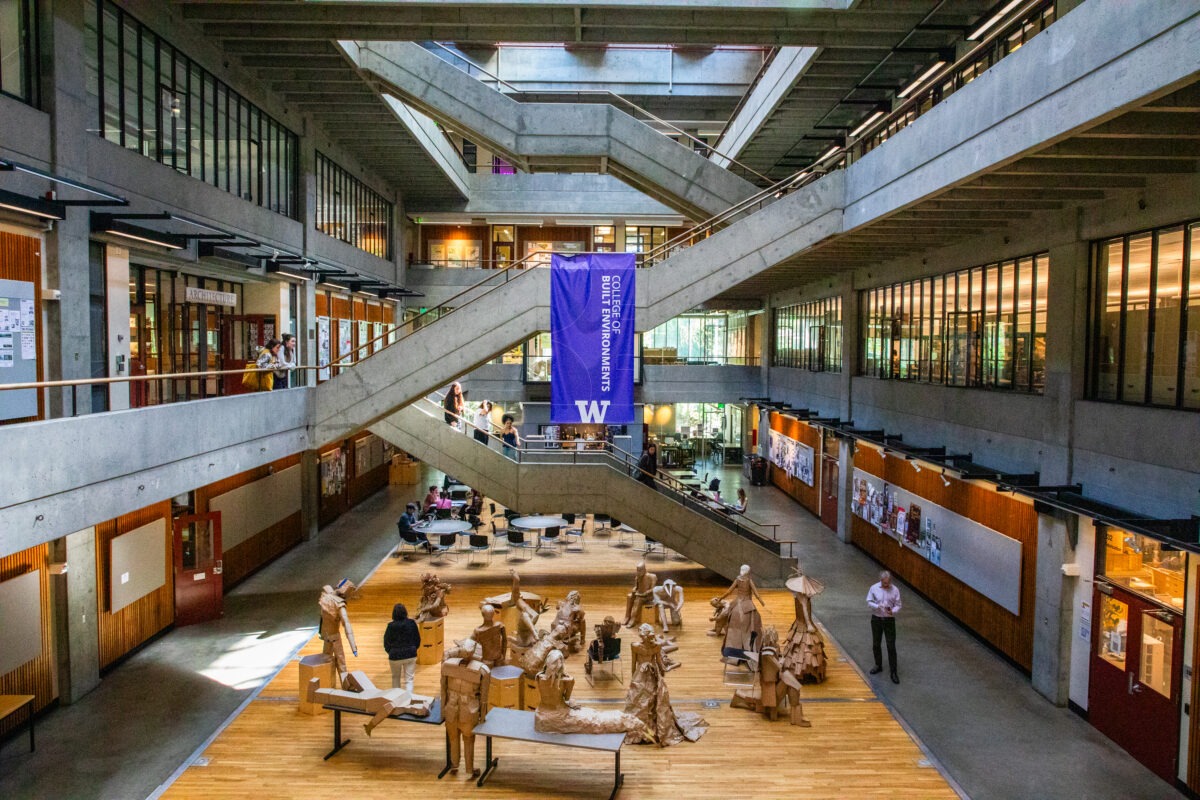
This spring, Gould Court filled with a curious crowd—not people, but full-size cardboard stand-ins. It wasn’t performance art. It was the first step in ARCH 231: Making and Craft, also known as Making and Meaning, where students move from human-scale studies to full-scale benches built by hand.
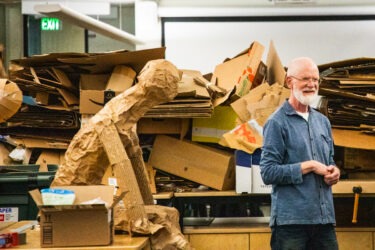
The lab is led by Associate Teaching Professor Jim Nicholls in the Department of Architecture, with support from instructors Halle DelMargo, Dominc Kaufer, Claire Showalter, Marcus Crider, and Veronica Leaños. Together, they guide students in using recycled materials and collaborative methods to explore key ideas in building fabrication and architectural construction. At the heart of the lab is a “learning by doing” philosophy, where students rapidly translate concepts into built form.
Through hands-on projects, the laboratory explores how materials, scale, and design work together—starting with small exercises and building toward a collaborative final project. The course emphasizes making as a way to understand the built environment and how ideas become real-world experiences. “Each individual’s choices are evident in their work,” said Nicholls, “Although the material and experiment prompts are shared in the class, the individual autobiographical work is rewarding to see.”
Students come to the lab from a range of disciplines, including architecture, landscape architecture, visual art, planning, and engineering. While some arrive with shop experience, others pick up a power drill for the first time. “I didn’t know what to expect at first,” said Gabriel Meyer-Yen, a second-year landscape architecture student. “But I stayed because I was having fun—and learning so much. It’s unlike any other class I’ve taken.”
The course begins with a team project: using recycled cardboard to build a life-sized human figure in motion. Students are challenged to consider proportion, balance, and material strength on a real scale. The results were imaginative and diverse: a wizard cloaked in paper layers, a climber suspended midair, a runner captured in a moment of motion. “We struggled with getting everything to balance,” recalled Kyle Reyes, a prospective architectural design major. “On paper, it’s easy. But when you’re building at full scale, you have to think about structure and stability in a new way.”
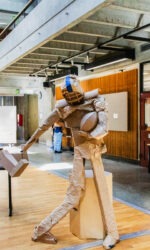
Meyer-Yen’s group created a six-foot-tall figure in the classic Heisman pose, drawing on their shared experiences in athletics. “It was surprisingly difficult,” he said. “But working through the structural challenges taught us a lot—not just about cardboard, but about how form and material work together.”
After cardboard comes wood and natural materials. In the next project, students work individually to construct animals from salvaged materials—sticks, wood scraps, branches, and pinecones. The animals are often deeply personal. Meyer-Yen created a large bear modeled after “Berry,” a bear that frequented his childhood backyard in Southern California. “I looked at its skeleton and stance, not just a photo,” he said. “I wanted to capture the feeling of something larger than yourself.”
Other students brought a wide range of creatures to life: a sea turtle crafted from carefully selected found wood, a spider monkey hanging midair, a cat with detailed joints, and a bear built from stacked chairs. Violet Portteus, a student studying Community, Environment & Planning, described the joy of shaping a figure intuitively: “I just made it as I went, and in the end, it all came together.”
The learning extended beyond design into craft. For many, it was their first time using shop tools. “I was in the woodshop way more for the animal project,” said Max Smee, a double major in art drawing + painting and architectural studies. “I learned to use drills, saws—everything. I came in knowing nothing.” Others used the opportunity to explore different construction styles. “I wanted to do minimal cutting,” Reyes said of his turtle. “I searched for pieces that already had the shape I needed, and treated it like a puzzle.”
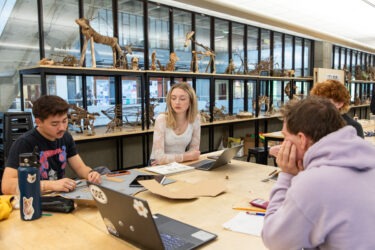
The final project brings students back together in teams to build full-scale benches using a limited number of 2×6 boards. Each group designs for a real site on or near campus. Reyes, Smee, Portteus, and fellow classmate Thomas Stacy—a prospective civil engineering student—focused on an asymmetrical, curved bench tucked into a corner near Architecture Hall, creating a space for quiet conversations. “We wanted it to feel organic,” Reyes shared. “Something that fits into the environment and invites people in.”
“We’re building a star-shaped bench,” said Meyer-Yen. “It’s whimsical, but also designed to frame a view. It invites people to stop, sit, and take in the campus.” Other students opted for curved or asymmetrical forms, using organic shapes to complement the surrounding landscape. “It’s about how people interact with space,” Portteus explained. “We’re not just making furniture—we’re designing experiences.”
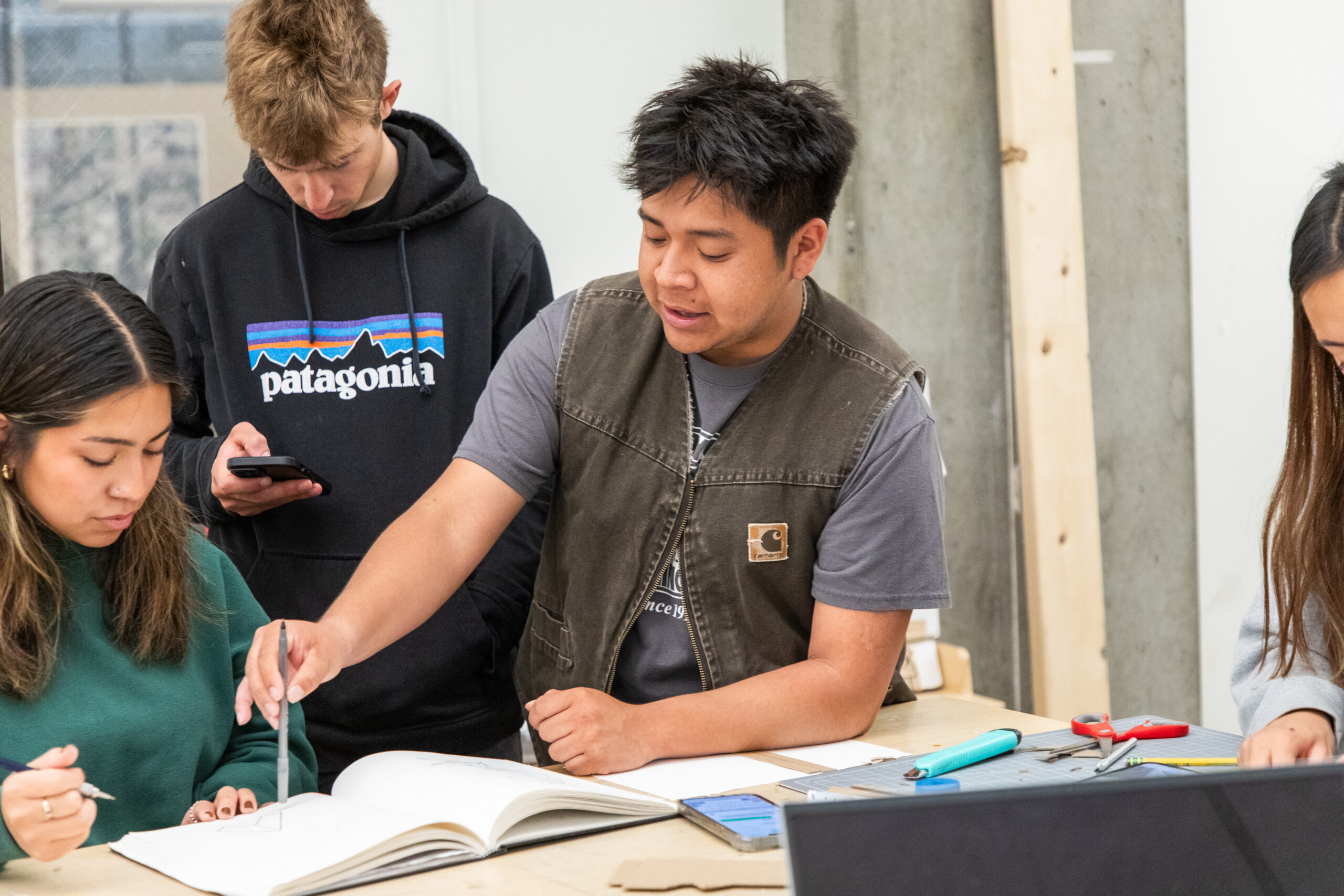
That idea—designing experiences—is a core takeaway of the lab. As highlighted in a 2023 UW News article, ARCH 231’s bench project exemplifies how Built Environments courses connect material, context, and community. Students don’t just draw. They build, collaborate, adapt, and reflect.
Students not only gain technical and creative skills but valuable partnerships, “I’m most excited to leave with not only the construction knowledge,” said Smee, “but also the connections and people that I got through having to learn all of this.”
For students across disciplines, ARCH 231 offers a glimpse into the broader mission of the College of Built Environments: to prepare future makers, thinkers, and leaders to shape the world through thoughtful, engaged design. Whether they pursue architecture, art, urban planning, or civil engineering, students walk away with practical skills, collaborative experience, and a deeper understanding of how ideas become built realities.
Explore images from ARCH 231 below.